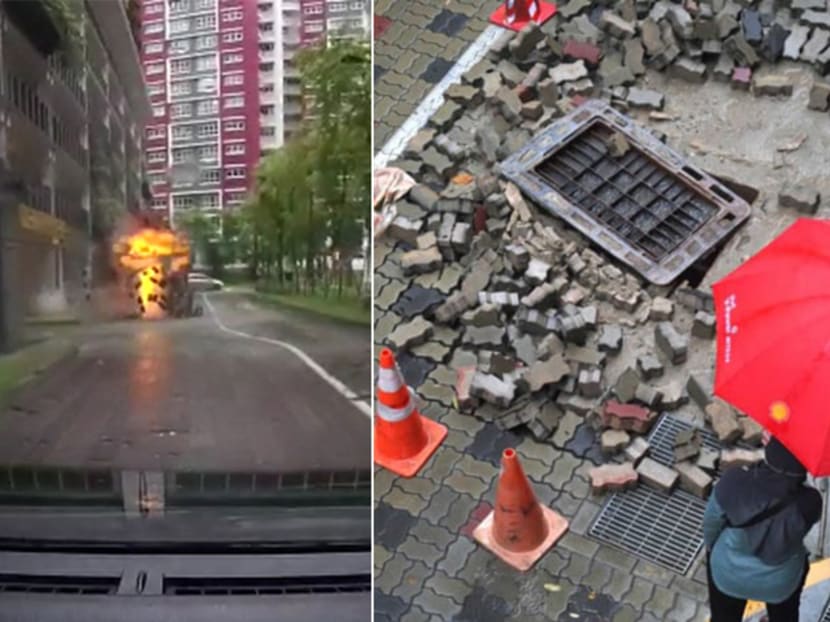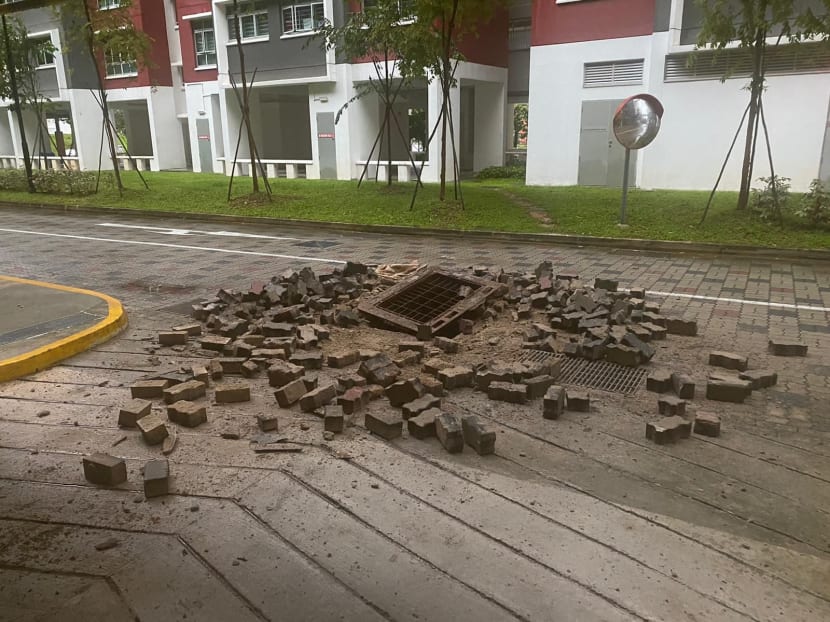Explainer: How a lightning strike can lead to a manhole explosion
SINGAPORE — It takes a perfect storm of foul circumstances — a lightning strike, insufficient cable shielding, and a build-up of combustible gases or aerosols in a tight space — to cause a manhole explosion such as the one in Bukit Batok on Tuesday morning (Aug 24), engineers said.

A manhole blows up outside a multi-storey car park at Bukit Batok West on Aug 24, 2021, scattering bricks. .
- On Aug 24, an in-car camera captured a flash of light followed by an exploding manhole in Bukit Batok
- Such incidents are rare in Singapore, but do happen since the country is lightning-prone
- This was a perfect storm of conditions, one expert said
- Three conditions or elements must exist for a manhole explosion to occur: Fuel, oxygen and an ignition source
SINGAPORE — It takes a perfect storm of foul circumstances to cause a manhole explosion such as the one in Bukit Batok on Tuesday morning (Aug 24), engineers said, and they are a lightning strike, insufficient cable shielding, and a build-up of combustible gases or aerosols in a tight space.
These occurrences do happen overseas but are relatively rare here, they told TODAY when asked about the flash fire near a multi-storey car park at Block 439, Bukit Batok West Avenue 8.
A 25-second video from a car’s in-vehicle camera showed a flash of white light immediately before the incident.
Fortunately, despite the force of the blast throwing bricks and the manhole cover into the air, no one was injured. The manhole was maintained by a telecommunications company.
While uncommon, such incidents may still happen in lightning-prone Singapore, and it is why the authorities have to properly investigate to determine if this was an isolated incident or otherwise, the experts said.
WHY MANHOLES BLOW UP DURING A LIGHTNING STORM
Analysing the video, Emeritus Professor Liew Ah Choy, a lightning protection expert, said that the flash of white light was likely to be a lightning strike at one of the buildings there, noting that a real-time lightning tracker by the National Environment Agency registered a strike in the vicinity at around 8.40am that day — believed to be about the same time as the camera footage.
Emeritus Prof Liew, who is from the National University of Singapore’s department of electrical and computer engineering, said: “It was likely to be a perfect storm of elements — lightning hit the building, the electrical current flowed into the ground, spread into the manhole and led to the explosion.”

While investigations into the Bukit Batok explosion are still ongoing, three experts interviewed by TODAY offered explanations as to how manholes can explode in such a fashion.
Professor Lock Kai Sang from the Singapore Institute of Technology’s engineering cluster said that three conditions or elements must exist for a manhole explosion: Fuel, oxygen and an ignition source.
“The fuel could be carbon monoxide due to ageing and decay of insulation materials of cables, and methane gas due to decomposition of biological wastes. The ignition source could be a lightning incident or a spark created by cable fault,” he said.
IGNITION
With tall buildings in Singapore that come equipped with lightning rods, it is unlikely that the lightning bolt hit the manhole or the ground area near it directly, Emeritus Prof Liew said.
It probably hit a building’s lightning protection system, which directs the electrical surge into a rod in the ground, where the current is then dissipated downwards and in an expanding sphere.
“Along the way, the current will encounter ‘discontinuities’ like manholes, and (any) difference in electrical difference can result in sparks,” he added.
Dr Teo Tee Hui, a council member of the Institution of Engineers Singapore, said that such a possibility is why Singapore’s stringent practices require some types of underground cable networks, such as those carrying electrical power to homes, to be properly protected by earth fault devices.
These devices function like circuit breakers, which can direct any dangerous surges in electrical current safely away from people and property.
Telecom cables, however, do not typically come with such surge protection due to the small amount of current they need to carry data signals. And because these cables are often spliced and bonded together by telco technicians whenever they conduct their maintenance, they are often not sufficiently shielded from electrical surges, Dr Teo said.
“It is possible that a surge protection device for telco cables could prevent sparks that could ignite the gases within spaces such as manholes.”
FUEL
As for these gases or aerosols, it is possible that methane from underground sewage or from decomposing material could have built up within the semi-airtight manhole, the experts said.
Another possibility is gases from overheated cables, because the heat could cause their polyethylene insulation layer to decay, thereby creating carbon monoxide as a by-product. This is why maintenance workers have to vent these toxic gases whenever they enter such manholes.
The decaying insulation of these cables could also result in conditions that would allow electrical sparking to happen, Prof Lock said.
While no possibilities should be ruled out at this point, Prof Lock said that the Bukit Batok incident is unlikely due to a seepage of liquefied petroleum gas, otherwise “the incident would have been more disastrous”.
In any case, such gases become trapped in manholes because there is nowhere else for the gas to travel when the manhole cover is closed, the experts said.
They noted that these access ports into manholes are often designed to be strong enough to withstand corrosion and the weight from vehicles and people above ground, but are not meant to contain pressurised gases.
Hence, a spark from cables or from the lightning strike, combined with the gaseous fuel and the oxygen within the manhole, can lead to an explosion.
Prof Lock said that the task for authorities now is to investigate and identify the root causes of the incident to determine whether this was an isolated incident caused by these confluence of factors.
“If the investigation finds that the explosive gas can be accumulated under ‘normal’ conditions, these ‘conditions’ must be mitigated via appropriate measures.”











